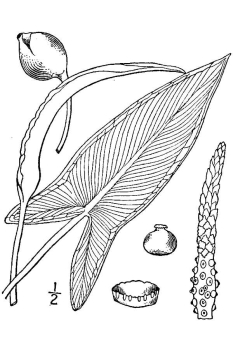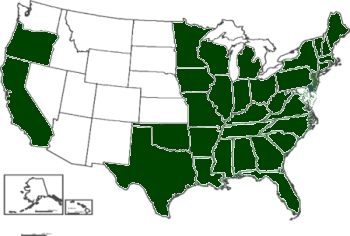Peltandra virginica
 |
 |
Photo courtesy USDA Plants database |
Britton & Brown |
| Botanical name: | Peltandra virginica |
| Common name: | Arrow arum or Tuckahoe |
| Group: | monocot |
| Family: | Araceae |
| Growth type: | forb/herb |
| Duration: | Perennial bulb |
| Origin: | native |
| Plant height: | 1-2' |
| Foliage: | bright green, smooth, succulent leaves, arrow shaped, 10-12" long, 3-8" wide, whitish underside, with three prominent veins with an abrupt, sharp tip |
| Flower: | Monoecious, with both male and female parts in a 4-8" partially closed green spathe |
| Flowering time: | Blooms May to July.; green fruit is up to 1/2" long, with one seed, and is floatable. Upon separation from the stem, the fruit turns black (USDA). |
| Habitat: | Growing in water along the edges of all the rivers and tributary streams of the state; along the muddy shores of the Delaware and the tidewater creeks below Philadelphia (Stone, p. 315) |
| Range in New Jersey: | statewide |
| Heritage ranking, if any: | n/a |
| Distribution: |  |
| Misc. | Peltandra is an obligate wetland plant, that is, occurs almost always (estimated probability 99%) under
natural conditions in wetlands. "The flower, which resembles a very slender green calla lily, raises itself among the leaf stems for a short time, and then, as the seed develops, the stalk curves downward, drawiing the pod beneath the water and burying it in the soft mud" (Stone, 315). Pelte, Greek "a small shield", and aner, "stamen, in the shape of". According to the USDA, the fruit is a preferred food of wood ducks, and is also eaten by muskrats and rails. It also provides cover to waterfowl, wading birds, insects, and aquatic mammals. The foliage contains calcium oxalate, which is toxic. Peltandra (tuckahoe, or "tockawhough") was eaten by the Native Americans, as the calcium oxalate can be destroyed by long cooking or heating and drying. It was used as a starch, for breads and soups. The flower is pollinated by a "chloropid fly, Elachiptera formosa" (Eflora) Captn. John Smith, of the Virginia Indians in 1612: "The chief roote they have for food is called Tockawhough. It groweth like a flagge in low muddy freshes. In one day a Savage will gather sufficient for a weeke. These rootes are much of the greatness and taste of Potatoes. They use to cover a great many of them with oke leaves and ferne, and then cover all with earth in the manner of a colepit; over it, on each side they continue a great fire 24 hours before they dare eat it. Raw it is no better than poison, and being roasted, except it be tender and the heat abated, or sliced and dried in the sun, mixed with sorrell and meale or such like, it will prickle and grate the throat extreamely, and yet in sommer they use it ordinarily for bread." (Description of Virginia and proceeds of the colony. Oxford. 1512. Included in the narratives of Early Virginia, ed. Tyler 1959 New York.) |